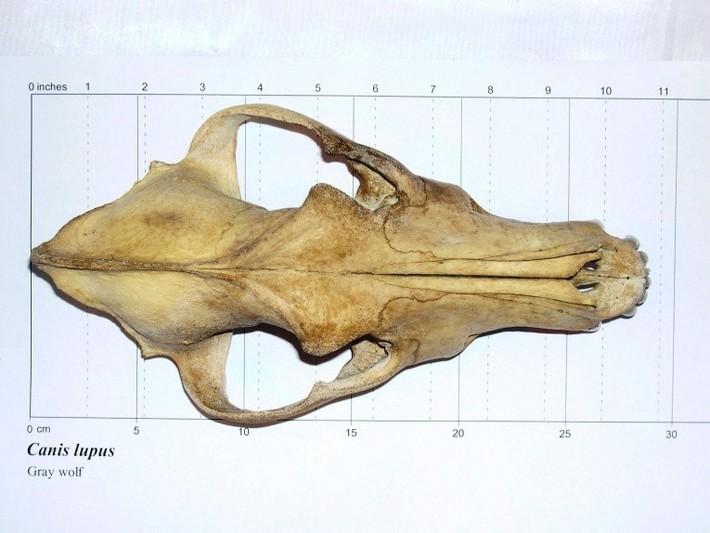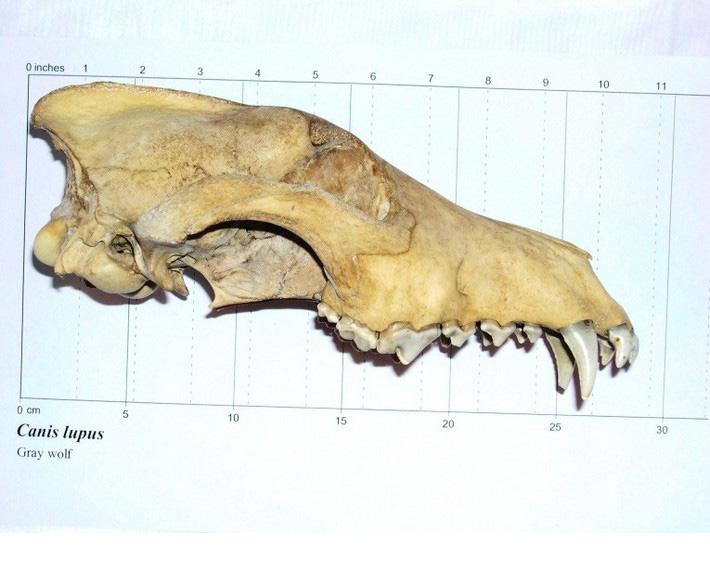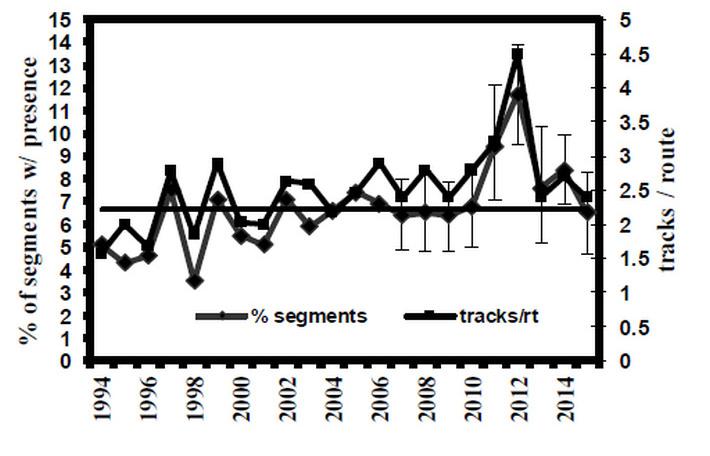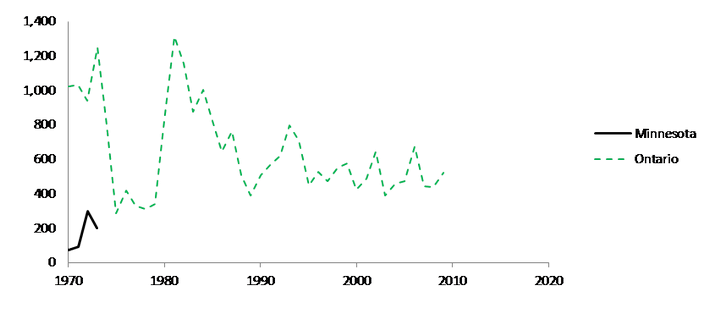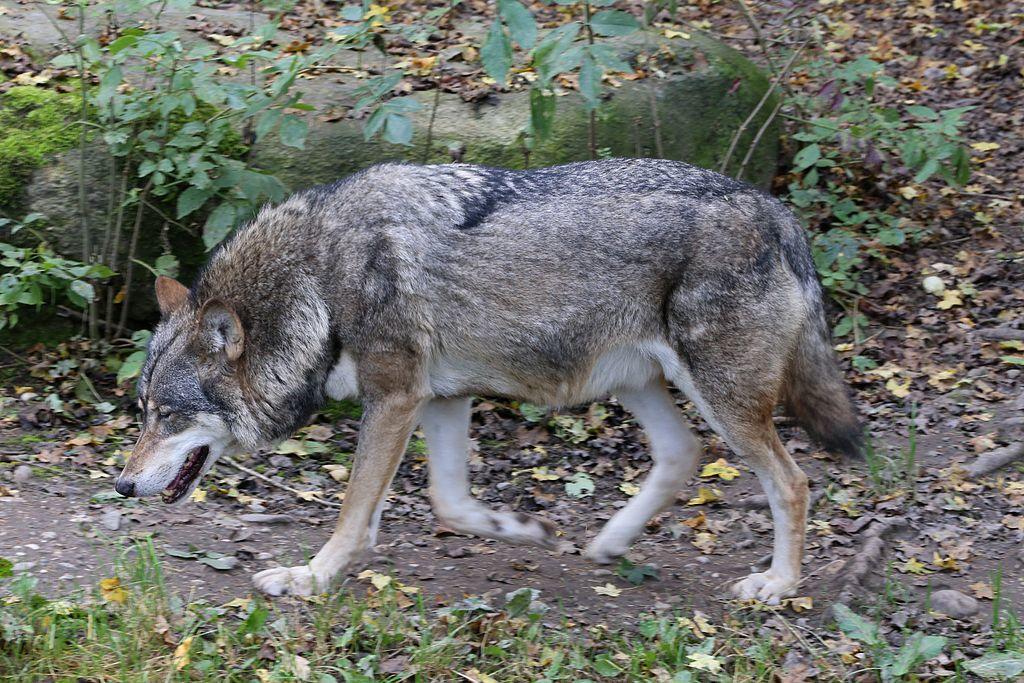
Description
Wolves (Canis lupus) are large carnivores in the dog family (Canidae). The major identification challenge is distinguishing between wolves, coyotes, and domestic dogs.
Adult wolves are twice as heavy as adult coyotes, and have a broader muzzle than coyotes. Generally, wolves are predominately gray or black, and lack the yellowish or reddish color patterns found in coyotes. Coyotes carry their tail low while running, while wolves carry their tail horizontally, and domestic dog backs bob when they run. Most domestic dogs have curved tail tips. Wolves have a narrow chest, while domestic dogs have a broader chest, resulting in a wider stance for domestic dogs.
Size
Measurements from Minnesota are from Hazard (1982), from Wisconsin are from Jackson (1961), and from the Eastern United States are from Hamilton and Whitaker (1998). Total length averaged 5.2’ (1.6 m) in the Eastern United States, ranged from 4.9’ to 5.6’ (1.5-1.7 m) in Wisconsin, and ranged from 4.9’ to 5.2’ (1.5-1.6 m) in Minnesota. Tail length averaged 1.3’ (0.4 m) in the Eastern United States, ranged from 1.3’ to 1.6’ (0.4-0.5 m) in Wisconsin, and ranged from 1.0’ to 1.6’ (0.3-0.5 m) in Minnesota. Body weight ranged from 57 to 99 lbs (26-45 kg) in Wisconsin. Male body weight ranged from 44 to 176 lbs (20-80 kg) in Minnesota, while female body weight ranged from 49 to 121 lbs (18-55 kg).
Males are typically larger than females.
Distribution & Status
The current gray wolf populations in North America have been severely constricted northwards relative to historical distributions. Initially distributed across North America, human development and interaction has reduced their population and distribution. The wolf’s range has contracted by 42% since the 19th century (Laliberte and Ripple, 2004). In the continental U.S., the only viable populations of gray wolves were found in Northern Minnesota and Isle Royale from 1960-1989 (Roell et al., 2010). Gray wolves have recovered and are now present in the Northern Rocky Mountains and the Great Lakes Region. The Great Lakes population segment of gray wolves was taken off the federal endangered species list in 2012 (Erb and Sampson, 2013).
Populations are apparently secure in Ontario and Wisconsin, vulnerable in Minnesota and Michigan, and are presumed extirpated from Iowa and North Dakota.
Worldwide, Canis lupus was the world’s most widely distributed mammal, found in much of the northern hemisphere north of 12-15 degrees latitude. Wolves have been extirpated from much of the U.S., Mexico, and Western Europe, but still have an IUCN rank of Least Concern.
Incidence in Minnesota
In Minnesota, wolves can only be killed in defense of human life. Only government agents are authorized to kill wolves to protect pets or livestock. All incidents should be reported to a Minnesota DNR conservation officer. Hunting and trapping are regulated by the Minnesota Department of Natural Resources, regulations here.
Population Trends
To help assess population trends, we can look at regional furbearer harvest data, methods here
In Ontario, harvest declined sharply in the late 1970s, before rebounding in the early 1980s. From a peak in the early 1980s, harvest levels declined until the late 1980s. Since the late 1980s, harvest has been relatively constant. There is not enough data from Minnesota to detect a trend.
Life History
Wolves can live in a variety of habitats ranging from forests to mountains to deserts to swamps. Today, most wolves have home ranges in forested regions that contain prey. Wolves are social animals that are often found in packs. A typical wolf pack has a dominant alpha male and alpha female breeding pair, subadult and juvenile offspring, and other subordinate adults. Wolves howl to announce their presence, and mark their territories with scat and urine. Wolves mate in February; 2-7 pups are born 63 days later and reared in an underground den (Hamilton and Whitaker, 1998). Pups stay with parents for at least one year, and don’t disperse until at least 2 years old. Wolves feed primarily on deer, moose, and beavers, but will also eat hares, birds, and small mammals (Forsyth, 1985). The most serious threat to wolf numbers in northeast Minnesota is decreasing in prey population (Hazard, 1982).
Contacts with Humans
Wolves have historically been misjudged by many people, persecuted, and extirpated from much of their historical range (Hazard, 1982; Reynolds and Tapper, 1996; Laliberte and Ripple, 2004). Although wolves are sometimes viewed as a serious threat to livestock, in Minnesota a very low percentage of livestock is taken by wolves. From 1975-1986, only 0.33% of livestock and poultry producers in Minnesota reported losses to wolves (Fritts et al., 1992). There are no instances of wolves killing or injuring people in Minnesota, yet some continue to harbor fear of wolf attacks (Hazard 1982). Wolves generally avoid people, and should be viewed as an important component of a healthy environment.
